
French Silver & Carnelian Glass Rosary with Compass Marking
Antique French silver & carnelian glass rosary marked French silver small mark & compass?. Approx length 54 cm

Antique novelty fob compass, 16.5 mm - Rare Collectible Item
Antique novelty fob compass, size 16.5 mm
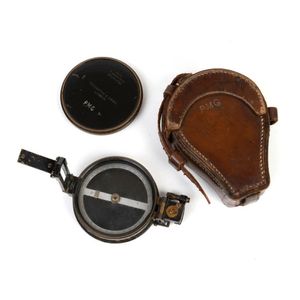
Mid-20th Century Prismatic Compass by Troughton & Simms
A prismatic compass by Troughton & Simms made for Gaunt & Co., Melbourne, mid 20th century, the folding instrument stamped Pmg, with leather case stamped Pmg, the case 13 cm long
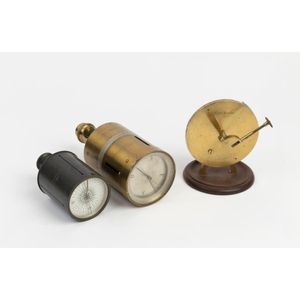
French Brass Vineyard Setters Compass and Scientific Surveying Instruments
An antique French brass vineyard setters compass, circa 1890s, together with two brass and black metal scientific and surveying instruments, late 19th century, one raised on a wooden stand marked Cary, London, the largest 20 cm high
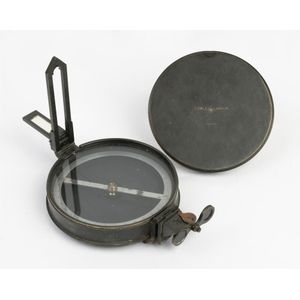
Stanley Prismatic Brass Surveyor's Compass (London, circa 1900)
A Prismatic brass surveyor's compass, by Stanley, London, circa 1900, with leather carrying case and shoulder strap, 7 cm diameter (approx.)
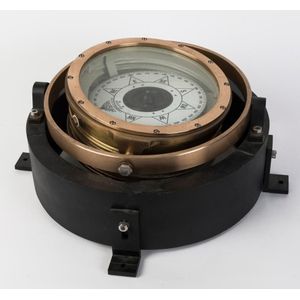
Gimbaled Brass Mount Ship's Compass: 44cm Diameter
A ship's compass in gimbaled brass mount, 44 cm diameter overall
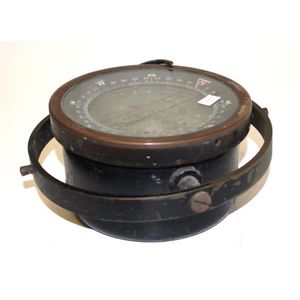
Vintage Seibel Naval Gimble Compass - Type T1A, #2427
Vintage Seibel naval gimble compass brass and steel cased naval compass, marked 'Type T1A,' and # 2427, diameter 16.5 cm dial.

CT Good's Architectural Instrument Box
W.H Harling Architechural instruments, carved wooden box with compass and rulers belonging to Charles Thomas 'Ct' good, Adelaides Leading Architect around 1900's and designer of her Majesty's Theatre
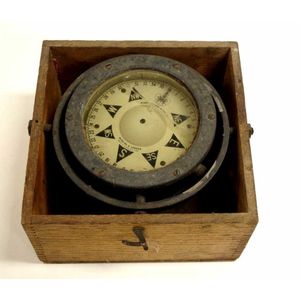
Marine Gimbal Compass by Henry Browne & Son Ltd
Henry Browne & Son Ltd boxed marine gimbal compass Barking & London, 19.5 cm x 19.5 cm, 12 cm highbox lid missing
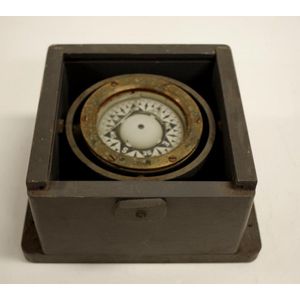
Sydney Marine Compass with Missing Cover
E. Esdaile & Sons Sydney boxed marine compass 17 cm x 21 cm, 11 cm high clear box cover missing
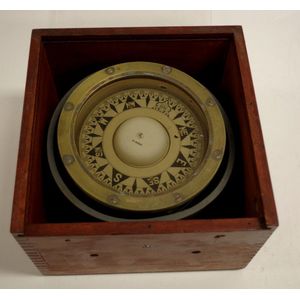
Sestrel Britain Marine Gimbal Compass - Compact and Precise
Sestrel Britain boxed marine gimbal compass 22.5 cm x 22.5 cm, 15 cm high
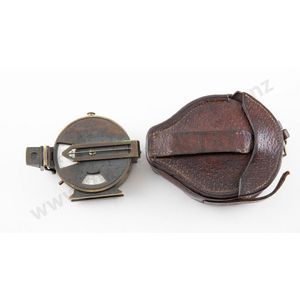
Peacock Auckland 1879 Compass-Clinometer with Barker Patent 1926
Barker patent 1926 combined compass & Clinometer stamped peacock Auckland 1879 with leather case,
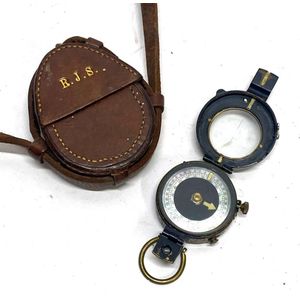
Sydney compass c.1930 with leather case
An E.Esdaile & Sons, Sydney compass, c.1930, marked to reverse W.T Forrrest, with leather case
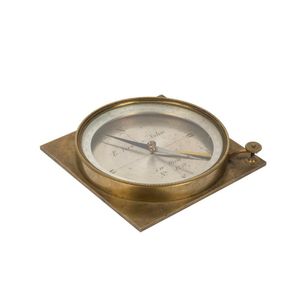
Vienna Brass Surveying Compass, 1860
A brass surveying dial compass, no. 1750 by E Kraft & Sohn, Vienna, circa 1860, 12.5 cm high, 12.5 cm wide, 2 cm deep
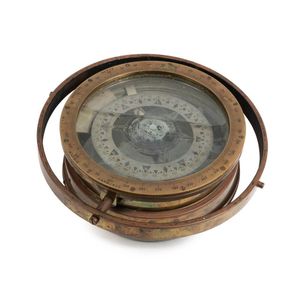
Geomar Gimbaled Brass Ships Compass, 1940
A gimbaled brass ships compass by Geomar, Madrid & Hamburg, circa 1940, the dial 27 cm diameter
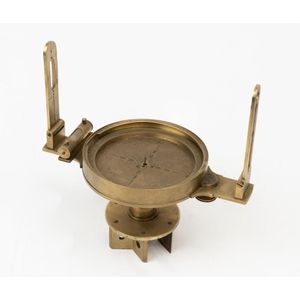
Brass Miner's Dial and Surveyor's Compass Set
A brass miner's dial by E. Kraft & Sohn, Vienna, no. 318, late 19th century, together with a brass surveyors compass, the boxed compass 6 cm high, 27 cm wide, 19 cm deep
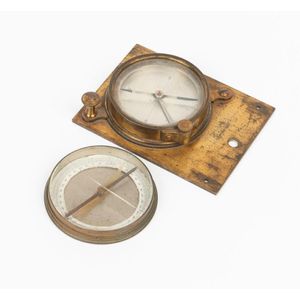
19th Century Brass Compass with Mount
An antique mounted brass compass together with a compass, 19th century, the largest 12 cm high, 9.5 cm wide
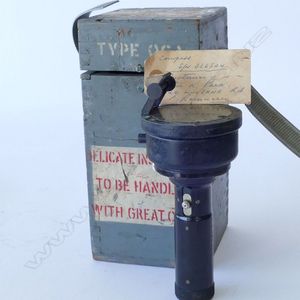
Sir Keith Park's Compass with Provenance
A compass belonging to air chief Marshal Sir Keith park, Gcb, KBE, MC & Bar, DFC (1892-1975) R.A.F. Type 06A, cased, hand-held with ebonised finish, in grey painted box with stencilled details, together with an old label, detailed in pen 'Compass S/N…
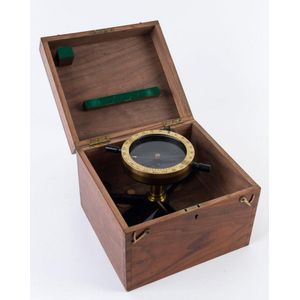
Negretti & Zambra Cedar Box Bearing Compass
Negretti and Zambra bearing compass in cedar box with brass fittings, stamped 'Negretti & Zambra, London, C.M.O. 20', the box 18 cm high, 23.5 cm wide, 21.5 cm deep.
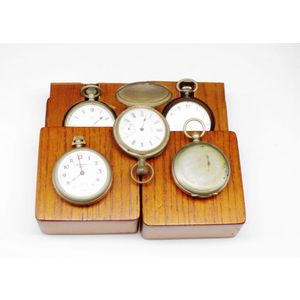
Non-functional Antique Watches and Compass Lot
Four fob watches and a compass includes a base metal Westclox working*, metal compass * not working, Sterling silver Waltham *not working, a metal Reliance J.Hart W. Matiland Swiss made * not working, a metal Hardy Bros Sydney * not working. * when tested.
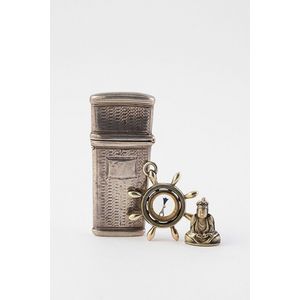
Antique Silver Etui with Knife, Compass, and Buddha Charm
19th century silver etui case, holding single knife, 10ct compass charm, silver Buddha charm holding miniature dice
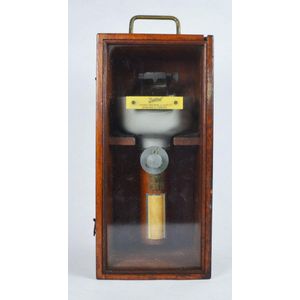
Early 20th Century Sestrel Hand Bearing Compass
'Sestrel' hand bearing compass by Henry Brown & Son Ltd. London fitted with a wet card compass having cardinal points & sight ing prism in case with Company logo plaque attached to the door panel. Early 20th century. Height 30.5 cm (case)
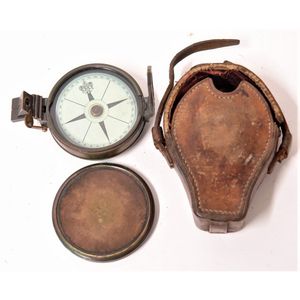
Antique Brass Compass with Leather Case and Viewing Sights
An early 20th century 'T. Peacock & Son, Auckland, New Zealand' brass compass in original leather case, with folding viewing sights and screw-receptacle for stand, diameter 7.5 cm, named to covering plate, in original stitched leather case
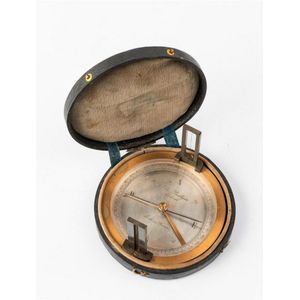
Boettger Field Compass with Silvered Dial and Fitted Case
A brass cased field compass retailled by Otto Boettger, Adelaide with a silvered dial and gun metal hands, fitted case 10.5 cm diameter
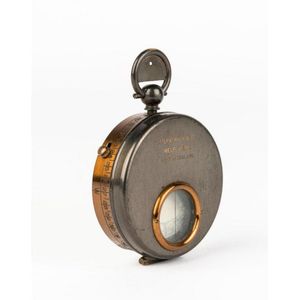
Gunmetal Compass by Kilpatrick & Co
A gunmetal cased compass retailed by Kilpatrick & Co., Melbourne 6.5 cm diameter
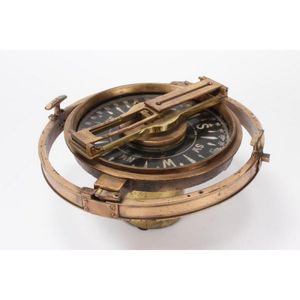
French Brass Nautical Compass (8 words)
French nautical compass, by Bbt Doignon, with black circular dial in brass fitting, diameter 32 cm
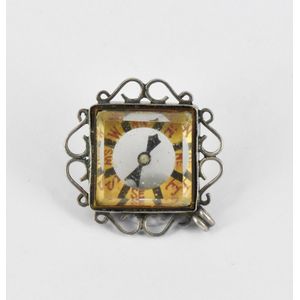
Square Sterling Silver Miniature Compass
A sterling silver miniature compass, square shaped. Length 25 mm. Weight all in 5.3g.
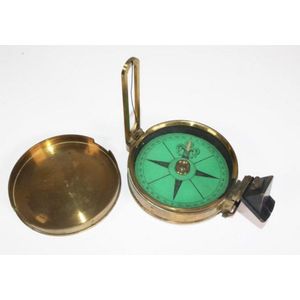
Victorian Brass Compass with Engraved Lid
Victorian brass compass lid engraved, 'Baker, 244 High Holborn, London,' diameter 7.5 cm
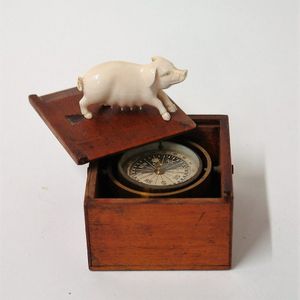
Gimballed compass and ivory pig in mahogany box
A c.1900 small gimballed compass and finely carved ivory pig, the compass in mahogany box by F. Barker & Son, the finely carved sow with head slightly raised.
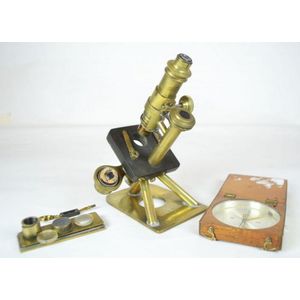
Brass Microscope and Mahogany Compass Case
Antique Scientific Instruments i) a brass microscope with some accessories, extra lens, slide mount, height 16 cm, II) a mahogany and brass compass case width 7 cm

Superior Magneto Corp Military Compass for Elite Personnel
A US military compass by superior Magneto Corp New York, Generally issued only to Cia, special Forces of officers in the US army
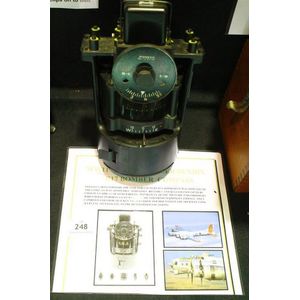
Rare US Airforce Compass with Versatile Capabilities
A rare US Airforce Pioneer/Bendix B-17 bomber compass, thought to be the only one of its type in Australia it was soon found that this compass was adaptable, versatile & reliable enough to be used in a variety of other roles, once landed it could be…
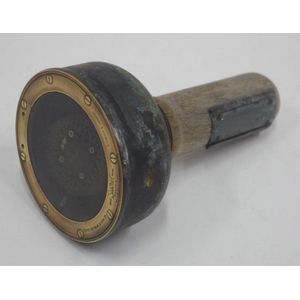
Antique Sestrel Compass by Henry Brown & Solds
Antique hand held ship's Sestrel compass made by Henry Brown & Solds, Barking & London.
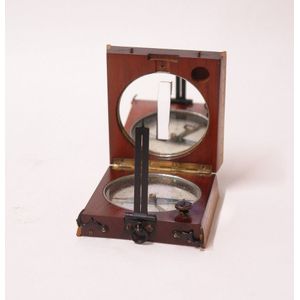
French Military Alidade Compass with Folding Mahogany Case
An early 20th century French military/surveyor's alidade compass, invented by Paul Peigne, the mahogany case with boxwood 16 cm rule to one side of the folding case, brass and ebonised metal fittings.
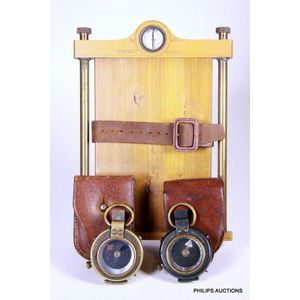
Edwardian Compass Set with Board and Pouches
Two Edwardian Short & Mason compasses and a compass board, early 20th century, a prismatic brass compass, number 313 and dated 1904, and; a Verner's pattern compass, number 534 dated 1908, both in original leather pouches, one marked G.I.T, the other F.L…

Negretti & Zambra Bearing Compass in Box
Negretti and Zambra bearing compass in box, 20th century, stamped Negretti & Zambra, London, C.M.O. 20, the box 18 cm high, 23.5 cm wide, 21.5 cm deep
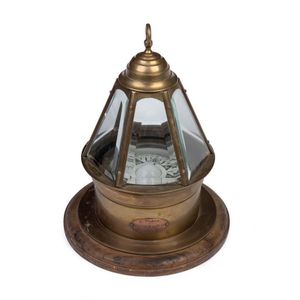
G. Plath Brass and Glass Ship Compass
A rare brass and glass ships compass labelled G. Plath, Hamburg, Germany
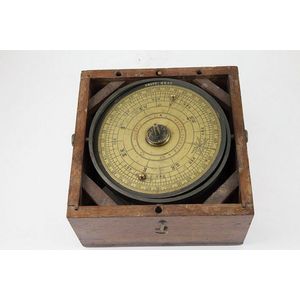
Antique Pelorus Compass with Sighting Veins
Late 19th century ships Pelorus compass by Whyte & Thomson of Glasgow in original mahogany box with azimuth sighting veins
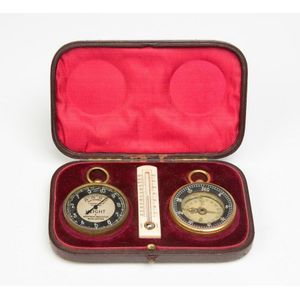
Antique Weather Instruments with Silver Box
A boxed compass, barometer and thermometer, circa 1900, retailed by C Werner & Co Ltd, Melbourne 150/250, 9.5 cm diameter, together with a silver box
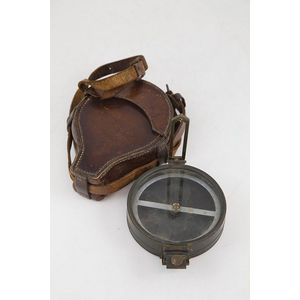
Bronzed Prismatic Compass with Leather Case by Littlejohn & Son
Vintage bronzed prismatic compass with original leather case, retailed by Littlejohn & Son, Wellington
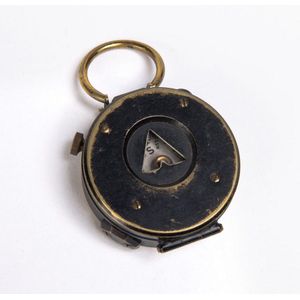
WWI Prismatic Field Compass by John Wardale & Co
A World War I period prismatic field compass by John Wardale &Co. London, dated 1918. 8 x 5.5 cm
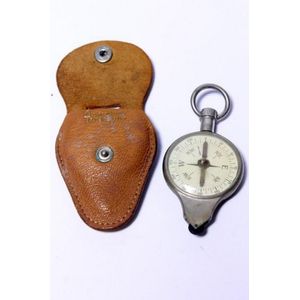
Compass and Map Reader with Metric Conversion
A compass & map reader, converts centremetres to kilometres
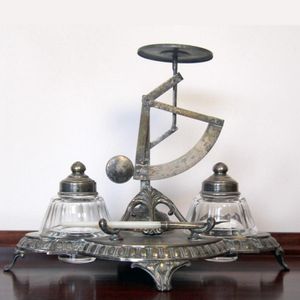
Plated Ink Stand Desk Set with Compass & Bottles
A plated ink stand desk set. Compass flanked by ink bottles on scrolled feet. 20 cm high
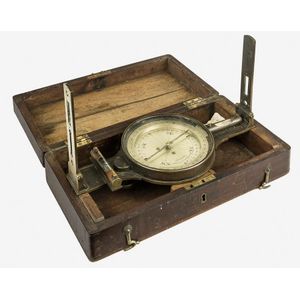
Troughton & Sons 18th Century Surveyor's Compass
18th century circumferentor or surveyor's compass by Troughton and Sons, London complete in original fitted case. Length 31 cm
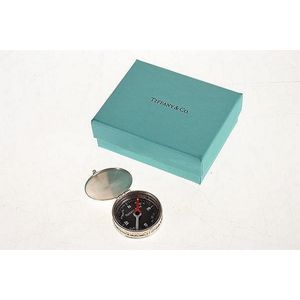
Tiffany & Co. Atlas Compass in Sterling Silver
A compass by Tiffany & Co., from the 'Atlas' collection, styled in sterling silver with a circular border of Roman numerals to the exterior, boxed, diameter 4 cm
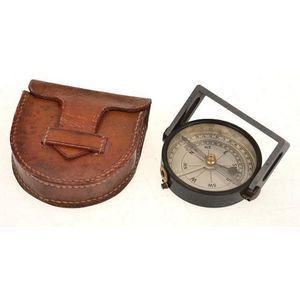
E.R. Watts & Son Vintage Brass Compass with Pouch
A vintage compass by E.R. Watts & Son London. Brass, with leather pouch
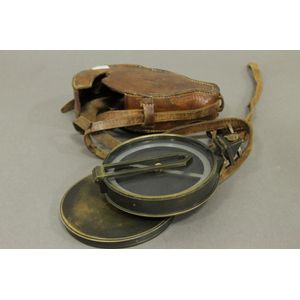
Victorian Surveyor's Sight Compass with Leather Case
An old Victorian patinated brass surveyors sight compass with fitted leather case. Made by Stanley, London. Length 17 cm
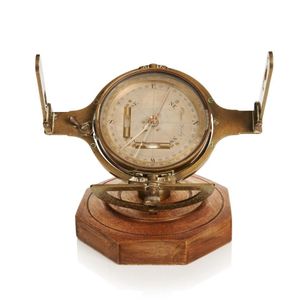
19th Century English Mining Dial with Sight Compass
A good 19th century heavy brass English mining dial with sight compass, levels and protractor. Signed on dial 'Davis, Derby' mounted with turning shaft and adjustments on an octagonal oak base. Used by surveyors above and below ground. Width 24 cm






 Loading more...
Loading more...